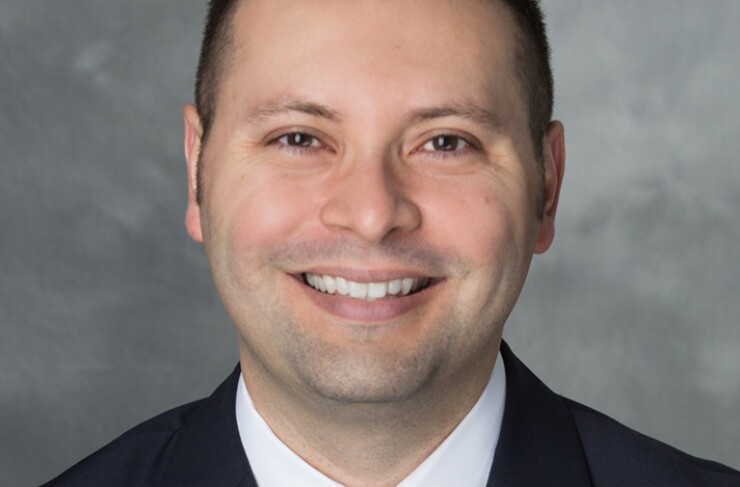
As expected, the Federal Open Market Committee
In his press conference, Fed Chair Jerome Powell said the panel is confident it's well positioned and prepared for all possibilities. Powell refused to make predictions about rate cuts, stating there will be situations where it would be appropriate to cut rates, but there may not be.
Powell acknowledged he hasn't met with President Donald Trump since January, but noted previous meetings with presidents occurred when he was invited. He said he's never requested a meeting with a president.
"The Committee is attentive to the risks to both sides of its dual mandate and judges that the
That statement "says it all," said Fitch Ratings Chief Economist Brian Coulton. "The tariff shock will reduce real GDP growth and raise prices at the same time, putting the Fed on the horns of a dilemma — the policy move necessary to maintain full employment is the opposite of that necessary to contain inflation. Moving one policy lever to hit two conflicting targets is problematic."
Given "solid" consumer spending and labor market metrics and imminent price increases, he said, "we think the Fed will hold off on further rate cuts until Q4 2025."
"The threat of having both inflation and unemployment rising simultaneously continues to create a big headache for the Fed's interest policy," said Wells Fargo Investment Institute global fixed income strategist Luis Alvarado.
"There is still a possibility where the federal funds rate could remain on hold at current levels in the near-term especially if inflation remains sticky. Under this level of uncertainty, we believe fixed-income investors may benefit by being exposed to the intermediate portion of the curve (3-7 year maturities) striking the best balance between attractive yield and less sensitivity to potential interest rate risk," Alvarado said.
"The Fed has been plunged into an almost impossible situation whereby its two mandates will likely move in opposite directions, but government policy — which is incredibly uncertain itself — will dictate both the timing and magnitudes of those moves," said Seema Shah, chief global strategist at Principal Asset Management.
The Fed will need to reduce rates, she said, "but, increasingly, it seems that the Fed will need to wait until late Q3 before the window of opportunity opens."
"Recent better than feared jobs data has supported the Fed's on-hold stance, and the onus is on the labor market to weaken sufficiently to bring a resumption of its easing cycle," said Ashish Shah, CIO of public investing at Goldman Sachs Asset Management. "Any weakening in the labor market, however, could take a number of months to become apparent and we see the odds skewed towards another 'hold' at next month's meeting."
By citing risks ahead, the Fed "has thrown the ball back into Trump's court," said Jay Woods, chief global strategist at Freedom Capital Markets.
"As a result, they will react when there is more clarity. Right now the only way to get that clarity is to get answers and not hopes of fruitful discussions from Washington," Woods said.
"The Fed is unlikely to commit too firmly to a rate-cut path before the 90-day pause on new tariffs ends on July 8," said Richard Flax, Moneyfarm chief investment officer. "Much of the current uncertainty has yet to filter through to the real economy. While there are anecdotal reports of inventory shortages, we've not yet seen a material impact on consumer prices. The next few macro and CPI data tranches will be critical in shaping the Fed's outlook."
The Fed's noting of upside risks increasing for both sides of its mandate "suggests little inclination to move until they are confident in the direction the economy is heading, meaning rate cuts could be delayed, but risk being sharper when they come," said ING Chief International Economist James Knightley.
While the market expects a July rate cut, he said, "we see the risk for slippage and it may be that the Fed kicks things off with a 50bp cut in September, just as they did in 2024."
Given the high level of uncertainty, the Fed's "reaction function in this environment will probably be delayed, and they may be a little slower to cut," said Sameer Samana, Wells Fargo Investment Institute head of global equities and real assets.
"By the time the Fed moves, it will be patently obvious what they should be doing," said Bill Zox, portfolio manager for Brandywine Global. "The real action to watch is between the Trump administration and the financial markets. If the Fed were to cut prematurely, the 10-year yield could move higher, which would be counterproductive."
BMO Chief U.S. Economist Scott Anderson expects the Fed to remain "on hold until it has a better feel for how the tariff-induced price hikes are spilling over into global supply chain disruptions and inflation expectations; and how sharply businesses are cutting costs, trimming payrolls, and putting investment on hold."
Chances of a June rate cut, as measured by Fed funds futures, fell to 26%, while it forecasts "a 90% probably of that the first cut comes by July, in line with our forecast," he said.





